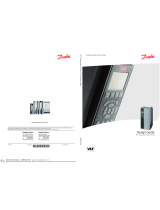
Danfoss CE labels the frequency converters in accordance
with the low-voltage directive. This means that if the
frequency converter is installed correctly, Danfoss
guarantees compliance with the low-voltage directive.
Danfoss issues a declaration of conformity that confirms
our CE labelling in accordance with the low-voltage
directive.
The CE label also applies to the EMC directive provided
that the instructions for EMC-correct installation and
filtering are followed. On this basis, a declaration of
conformity in accordance with the EMC directive is issued.
This Design Guide offers detailed instructions for installation
to ensure EMC-correct installation. Furthermore, Danfoss
specifies which the different products comply with.
Danfoss provides other types of assistance that can help
obtaining the best EMC result.
2.2.4
Compliance with EMC Directive
2004/108/EC
As mentioned, the frequency converter is mostly used by
professionals of the trade as a complex component
forming part of a larger appliance, system, or installation.
Note that the responsibility for the final EMC properties of
the appliance, system or installation rests with the installer.
As an aid to the installer, Danfoss has prepared EMC instal-
lation guidelines for the Power Drive system. The standards
and test levels stated for Power Drive systems are
complied with, provided that the EMC-correct instructions
for installation are followed, see .
2.3
Air humidity
The frequency converter has been designed to meet the
IEC/EN 60068-2-3 standard, EN 50178 pkt. 9.4.2.2 at 50 °C.
2.4
Aggressive Environments
A frequency converter contains a large number of
mechanical and electronic components. All are to some
extent vulnerable to environmental effects.
CAUTION
Do no install the frequency converter in environments
with airborne liquids, particles, or gases capable of
affecting and damaging the electronic components.
Failure to take the necessary protective measures
increases the risk of stoppages, thus reducing the life of
the frequency converter.
Degree of protection as per IEC 60529
The Safe Torque Off function may only be installed and
operated in a control cabinet with degree of protection
IP54 or higher (or equivalent environment). This is required
to avoid cross faults and short circuits between terminals,
connectors, tracks and safety-related circuitry caused by
foreign objects.
Liquids can be carried through the air and condense in the
frequency converter and may cause corrosion of
components and metal parts. Steam, oil, and salt water
may cause corrosion of components and metal parts. In
such environments, use equipment with enclosure rating IP
54/55. As an extra protection, coated printed circuit boards
can be ordered as an option.
Airborne particles such as dust may cause mechanical,
electrical, or thermal failure in the frequency converter. A
typical indicator of excessive levels of airborne particles is
dust particles around the frequency converter fan. In very
dusty environments, use equipment with enclosure rating
IP 54/55 or a cabinet for IP 00/IP 20/TYPE 1 equipment.
In environments with high temperatures and humidity,
corrosive gases such as sulphur, nitrogen, and chlorine
compounds cause chemical processes on the frequency
converter components.
Such chemical reactions rapidly affect and damage the
electronic components. In such environments, mount the
equipment in a cabinet with fresh air ventilation, keeping
aggressive gases away from the frequency converter.
An extra protection in such areas is a coating of the
printed circuit boards, which can be ordered as an option.
NOTICE
Mounting frequency converters in aggressive
environments increases the risk of stoppages and consid-
erably reduces the life of the frequency converter.
Before installing the frequency converter, check the
ambient air for liquids, particles, and gases. This is done by
observing existing installations in this environment. Typical
indicators of harmful airborne liquids are water or oil on
metal parts, or corrosion of metal parts.
Excessive dust particle levels are often found on instal-
lation cabinets and existing electrical installations. One
indicator of aggressive airborne gases is blackening of
copper rails and cable ends on existing installations.
D and E enclosure types have a stainless steel back-
channel option to provide additional protection in
aggressive environments. Proper ventilation is still required
for the internal components of the frequnecy converter.
Contact Danfoss for additional information.
Introduction to VLT® HVAC D...
Design Guide
MG11BC02 Danfoss A/S © Rev. 06/2014 All rights reserved. 13
2 2




















